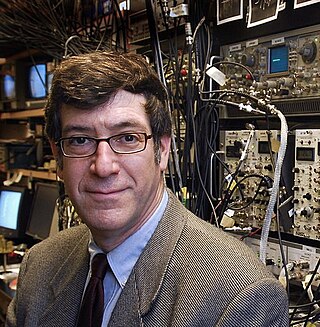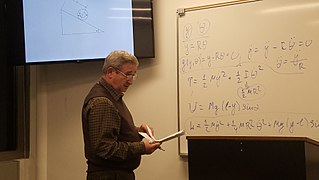Related Research Articles
Atomic physics is the field of physics that studies atoms as an isolated system of electrons and an atomic nucleus. Atomic physics typically refers to the study of atomic structure and the interaction between atoms. It is primarily concerned with the way in which electrons are arranged around the nucleus and the processes by which these arrangements change. This comprises ions, neutral atoms and, unless otherwise stated, it can be assumed that the term atom includes ions.
Atomic, molecular, and optical physics (AMO) is the study of matter–matter and light–matter interactions, at the scale of one or a few atoms and energy scales around several electron volts. The three areas are closely interrelated. AMO theory includes classical, semi-classical and quantum treatments. Typically, the theory and applications of emission, absorption, scattering of electromagnetic radiation (light) from excited atoms and molecules, analysis of spectroscopy, generation of lasers and masers, and the optical properties of matter in general, fall into these categories.

In physics, a plasmon is a quantum of plasma oscillation. Just as light consists of photons, the plasma oscillation consists of plasmons. The plasmon can be considered as a quasiparticle since it arises from the quantization of plasma oscillations, just like phonons are quantizations of mechanical vibrations. Thus, plasmons are collective oscillations of the free electron gas density. For example, at optical frequencies, plasmons can couple with a photon to create another quasiparticle called a plasmon polariton.
Plasma diagnostics are a pool of methods, instruments, and experimental techniques used to measure properties of a plasma, such as plasma components' density, distribution function over energy (temperature), their spatial profiles and dynamics, which enable to derive plasma parameters.
Quantum optics is a branch of atomic, molecular, and optical physics dealing with how individual quanta of light, known as photons, interact with atoms and molecules. It includes the study of the particle-like properties of photons. Photons have been used to test many of the counter-intuitive predictions of quantum mechanics, such as entanglement and teleportation, and are a useful resource for quantum information processing.
Naomi J. Halas is the Stanley C. Moore Professor in Electrical and Computer Engineering, and professor of biomedical engineering, chemistry and physics at Rice University. She is also the founding director of Rice University Laboratory for Nanophotonics, and the Smalley-Curl Institute. She invented the first nanoparticle with tunable plasmonic resonances, which are controlled by their shape and structure, and has won numerous awards for her pioneering work in the field of nanophotonics and plasmonics. She was also part of a team that developed the first dark pulse soliton in 1987 while working for IBM.

A glow discharge is a plasma formed by the passage of electric current through a gas. It is often created by applying a voltage between two electrodes in a glass tube containing a low-pressure gas. When the voltage exceeds a value called the striking voltage, the gas ionization becomes self-sustaining, and the tube glows with a colored light. The color depends on the gas used.
A particle beam is a stream of charged or neutral particles. In particle accelerators, these particles can move with a velocity close to the speed of light. There is a difference between the creation and control of charged particle beams and neutral particle beams, as only the first type can be manipulated to a sufficient extent by devices based on electromagnetism. The manipulation and diagnostics of charged particle beams at high kinetic energies using particle accelerators are main topics of accelerator physics.
Charles J. Joachain is a Belgian physicist.
The Max-Planck-Institut für Kernphysik is a research institute in Heidelberg, Germany.

Peter Zoller is a theoretical physicist from Austria. He is professor at the University of Innsbruck and works on quantum optics and quantum information and is best known for his pioneering research on quantum computing and quantum communication and for bridging quantum optics and solid state physics.

The Max Planck Institute for the Science of Light (MPL) performs basic research in optical metrology, optical communication, new optical materials, plasmonics and nanophotonics and optical applications in biology and medicine. It is part of the Max Planck Society and was founded on January 1, 2009 in Erlangen near Nuremberg. The institute is based on the Max Planck Research Group "Optics, Information and Photonics", which was founded in 2004 at the University of Erlangen-Nuremberg, as a precursor. The institute currently comprises four divisions.

The Max-Planck-Institute of Quantum Optics is a part of the Max Planck Society which operates 87 research facilities in Germany.

Mark George Raizen is an American physicist who conducts experiments on quantum optics and atom optics.

Vladimir (Vlad) M. Shalaev is a Distinguished Professor of Electrical and Computer Engineering and Scientific Director for Nanophotonics at Birck Nanotechnology Center, Purdue University.

The State Research Center for Optics and Material Sciences (OPTIMAS) connects two areas of research for which the University of Kaiserslautern has a national and international reputation, founded upon relevant contributions to the development of laser physics, photonics and plasmonics. Researchers in Kaiserslautern have also been prominent in the development of magnetic, electronic and molecular materials, as well as thin films, nanostructures and ultracold quantum gases. In order to continue building on this research foundation, OPTIMAS has been established at TU Kaiserslautern within the framework of the research initiative of the state of Rhineland-Palatinate.

Pedro Miguel Etxenike Landiribar, also known as Pedro Miguel Echenique, is a theoretical solid-state physicist, Professor of Condensed Matter Physics at the University of the Basque Country (UPV/EHU), and former minister of the Basque Autonomous Community.

Oleg Ivanovich Zatsarinny (1953-2021) was a Ukrainian-American theoretical physicist noted for his contributions to all aspects of research related to electron scattering in atoms. He was awarded the status of Fellow in the American Physical Society, after he was nominated by his Division of Atomic, Molecular & Optical Physics in 2008, for "the development of the B-Spline R-matrix method with non-orthogonal orbital sets for atomic structure calculations of exceptional accuracy and benchmark calculations for excitation and ionization of complex atoms and ions by photon and electron impact."

Fabrizio Carbone is an Italian and Swiss physicist and currently an Associate Professor at École Polytechnique Fédérale de Lausanne (EPFL). His research focuses on the study of matter in out of equilibrium conditions using ultrafast spectroscopy, diffraction and imaging techniques. In 2015, he attracted international attention by publishing a photography of light displaying both its quantum and classical nature.

Prineha Narang is an American physicist and computational material scientist. She is a Professor of Physical Sciences and Howard Reiss Chair at the University of California, Los Angeles (UCLA). Narang currently serves as a U.S. Science Envoy approved by the Secretary of State to identify opportunities for science and technology cooperation. Before moving to UCLA, she was first an Environmental Fellow at Harvard University Center for the Environment and then an Assistant Professor in the John A. Paulson School of Engineering and Applied Sciences at Harvard University. Narang’s work has been recognized internationally by many awards and a variety of special designations, including the Mildred Dresselhaus Prize, the 2021 IUPAP Young Scientist Prize in Computational Physics, a Friedrich Wilhelm Bessel Research Award from the Alexander von Humboldt Foundation, and a Max Planck Sabbatical Award from the Max Planck Society. Narang also received a National Science Foundation CAREER Award in 2020, was named a Moore Inventor Fellow by the Gordon and Betty Moore Foundation for the development for a fundamentally new strategy for single molecule sensing and environmental toxin metrology using picoscale quantum sensors, CIFAR Azrieli Global Scholar by the Canadian Institute for Advanced Research, and a Top Innovator by MIT Tech Review. Narang was awarded a Guggenheim Fellowship in 2023.
References
- ↑ "KU, K-State faculty receive Higuchi-KU Endowment Research Achievement Awards". The University of Kansas. 2023-02-09. Retrieved 2023-02-24.
- ↑ "Physics professor Thumm receives Humboldt Research Award".
- ↑ "Physics professor earns Commerce Bank Distinguished Graduate Faculty Award".
- ↑ "Uwe Thumm appointed Femtosecond and Attosecond Science and Technology fellow at national Swiss research center".
- ↑ "Thumm and Law Named APS Fellows".